What Is Cyberbullying and How to Protect Children From Cyberbullies?
Learn Types, Examples and Scales!
We do our very best to keep our children safe from potential dangers and threats. However, some of them, such as cyberbullying, are not that easy to recognize and require you to pay close attention to notice and overcome them.
In this article, we will cover the many ways your children can encounter a cyberbully and tips on how to prevent cyberbullying.
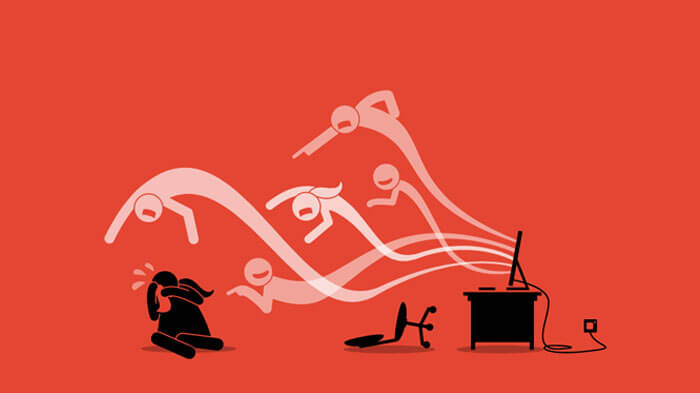
What Is Cyberbullying?
We can define cyberbullying as harassing, threatening, embarrassing someone, or posting targeted sharings about that person via technology. Cyberbullying actions, which are more common among children and young adults, can also be observed in adults. In such cases, serious legal sanctions are imposed on adults, including prison sentences.
Almost every adult would remember their highschool bully. How they would try to avoid any interactions with them in the hallways or how they would sneak in and out of class not to encounter them.
The difference between cyberbullying and bullying is that there is no need for physical force or face-to-face communication for cyberbullying as there is with bullying. Anyone using a device with an internet connection can perform a cyberbullying action, thus children can be more vulnerable to it. Bullies can be anonymous, as well as close friends of children and young people.s
Cyberbullying statistics show that 1 out of every 4 children is exposed to cyberbullying, while 1 out of 6 children know that they have been involved in such actions. The effects of cyberbullying can be tremendous and educating your children on this matter is important.
IMPORTANT: In the era of the internet, we can’t completely deprive children of technology. However, we can introduce them to its advantages by directing them to safe practices.
With the scientifically proven positive impacts on children and being a choice of more than 10+ million families, MentalUP is the best way to introduce your children to the safe, useful and entertaining world of the internet.

Cyberbullying on Social Media
There is no doubt that children love social media, however, social media and cyberbullying are closely linked. Such platforms make it easier for cyberbullies to take harmful actions. Here are some of the mediums where your child can encounter a cyberbully:
- Popular social networks like Facebook, Instagram, Twitter and Snapchat
- Text messages (SMS)
- Instant messaging features offered by e-mail providers, applications or social networks
- Chat rooms and e-mails
Cyberbullying on social media platforms is easier for the cyberbullies and more harmful for the victims for various reasons. The most common ones are:
- Children tend to overshare on these platforms, which allows for easy access to their information
- They spend most of their time on social media platforms making it easy to encounter cyberbullying actions
- Children care more about their presence on social media, therefore, they are more offensive and responsive to negative comments, which make them easy targets
Teaching your children how to use social media and the internet in a more efficient and careful way is important to keep them safe. This will not only keep them safe from cyberbullies, but it will also protect them from other dangers of the internet such as addiction. Read our article Positive and Negative Technology impacts on kids - Internet safety tips to learn about internet safety practices for your children.
Types of Cyberbullying
There are various types of cyberbullying, but they all have one intention - hurting someone. Knowing the types of dangers that your child can come across will help you protect them from it. Therefore, let’s dive right into it.
Exclusion
Exclusion is the act of leaving someone out on purpose and is one of the most common ways of teen cyberbullying. For example, your child might be excluded/uninvited to groups or parties while they see other friends being included, or left out of conversations that involve mutual friends.
Harassment
Harassment is a broad category that contains many types of cyberbullying. It generally refers to a sustained and constant pattern of hurtful or threatening online messages sent with the intention of doing harm to someone.
Outing/Doxing
Outing, also known as doxing, is the act of openly revealing sensitive or personal information or images about someone (without their consent) for malicious purposes. The effects of cyberbullying which are based on outing can be severe, especially among teenagers.
Trickery
Trickery is similar to outing, with an added element of deception. In such situations, the bully will befriend their target and gain their trust. Once achieved, they abuse that trust and share the victim’s secrets and private information with others.
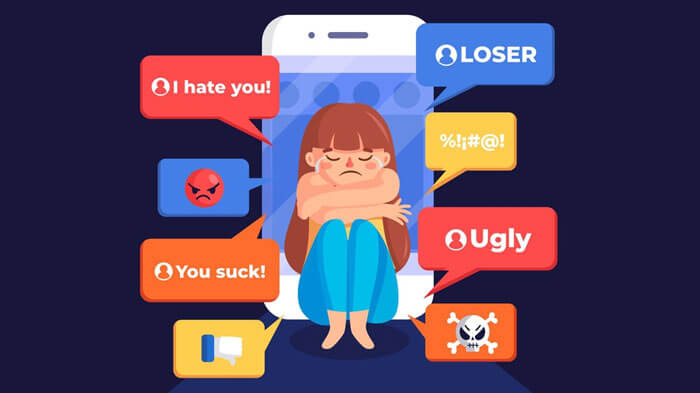
Cyberstalking
Cyberstalking is a form of cyberbullying that can extend to threats of physical harm to the child being targeted. Therefore, it can be extremely dangerous. It can include monitoring, false accusations, threats, and is often accompanied by offline stalking. It is a criminal offense and can result in serious consequences such as jail time for the perpetrator.
Fraping
One of the most common types of cyberbullying is fraping. A bully uses your child’s social media accounts to post inappropriate content under their name. For example, a bully can post inappropriate content about your child’s teacher or another classmate through your child’s profile. Your child will be the one to blame for such actions when in fact they have no involvement with it.
Masquerading
Masquerading happens when a bully creates a made-up profile or online identity with the sole purpose of cyberbullying someone. This could involve creating a fake email account, a fake social media profile, and selecting a new identity and photos to fool the victim. In these cases, the bully tends to be someone the victim knows quite well.
Dissing
Dissing is the act of a bully spreading cruel information about their target through public posts or private messages to either ruin their reputation or relationships with other people. In these situations, the bully tends to have a personal relationship with the victim, either as an acquaintance or as a friend.

Trolling
We are all familiar with trolls. Bullies seek out to intentionally upset others by posting provocative comments online. Usually, such actions come from people we don’t even know. It is important to teach your child to avoid interaction (via comments or by other means) with strangers in order to avoid trolling.
Flaming
Similar to trolling, flaming is the act of provoking someone through comments and direct messages. However, it can be more inflammatory because the main purpose is to lure the person into an online fight.
In the world of technology and the internet, it is important to teach children what to do when they experience unfavorable actions. Therefore, strong mental integrity and the ability of analytical thinking are some of the key elements that will provide guidance.
MentalUP provides children age-appropriate practices that will boost their mental skills and decision-making processes while also providing many other benefits.
Effects of Cyberbullying
The effects of cyberbullying can be very harmful, especially for children and teenagers. Cyberbullying causes significant emotional and psychological distress. These kinds of actions can cause children with anxiety, fear, depression, and low self-esteem. They may also experience physical symptoms and a lack of success at school.
If you notice one or more of these symptoms, you should look for ways on how to deal with cyberbullying, which we will cover further in the article.
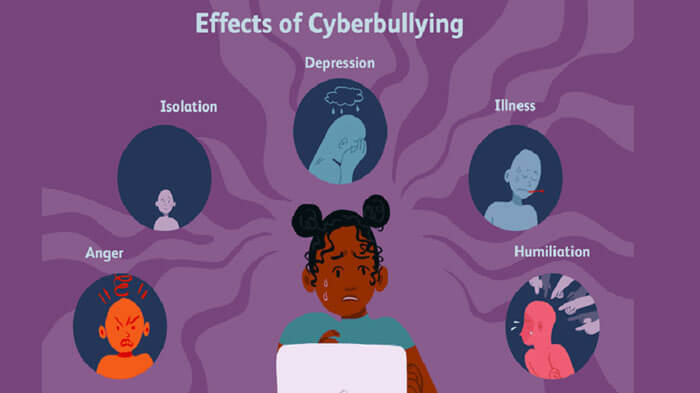
Feeling Overwhelmed
Being a target of cyberbullies, especially if there is more than one of them, like a group of friends or the whole class, can be crushing for a child. The stress of dealing with cyberbullying can cause kids to feel like the situation is more than they can handle.
Feeling Powerless and Unsafe
What is the impact of cyberbullying on the victims? They feel powerless and vulnerable, therefore, victims of cyberbullying tend to feel unsafe.
This is because, as we mentioned before, cyberbullying doesn’t have a specific time nor place. Unlike bullying, children are still vulnerable to cyberbullying through computers or cellphones while at home. They don’t have a safe place where they can escape from it.
Moreover, most cyberbullies prefer staying anonymous, although they may be someone we know. Not knowing who you’re interfering with can cause fear and other terrifying emotions.
Humiliation
Children are well aware that when something is on the internet, it’s there forever. This causes them to feel an endless humiliation.
If the cyberbullying is not directed personally through messages but posted publicly, having others know that they are being bullied can cause shame and humiliation for the child.
Feeling Worthless
Cyberbullies often attack their victims where they are most insecure, such as body shaming. This won’t only hurt emotionally but can cause physical harm as well.
For instance, a girl that is called fat may start unhealthy crash diets. Children may do almost anything to find a way to stop cyberbullying.
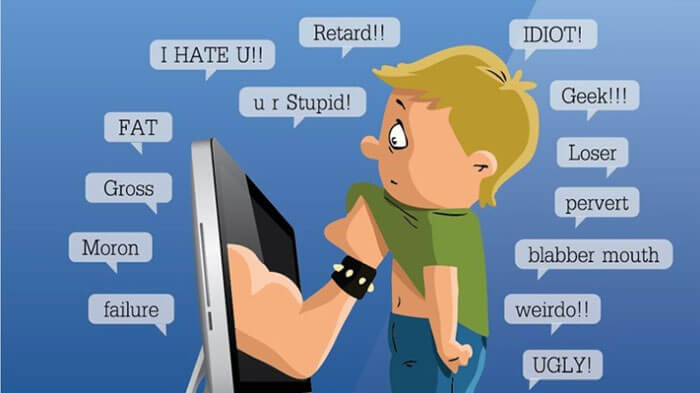
Need for Revenge
Becoming vengeful is one of the psychological effects of cyberbullying. Some victims can show anger and feel a need for revenge when they are cyberbullied. It is important to teach your child to forgive a bully and prevent them from becoming vengeful.
Moreover, cyberbullying facts show that such reactions from the victim can provoke the cyberbully, which can result in even more harassment.
Lose Interest
One of the most harmful effects of cyberbullying is that they become disinterested in school and other activities. Cyberbullying statistics show that victims often have much higher rates of absenteeism at school than non-bullied kids. They try to avoid interfering with the kids bullying them or they feel embarrassed and humiliated by the messages that were shared publicly, therefore they skip school.
Even if they attend their classes, children who are victims of cyberbullying find it difficult to concentrate and focus on school because of the ongoing anxiety and stress. As a result, they have lower grades, and sometimes, they even drop out of school or lose interest in continuing their education.
The anxiety and stress that cyberbullying can cause in children can be very exhausting. Children experiencing such situations can have trouble concentrating and focusing. This can also cause great harm to their educational success.
MentalUP offers educational games that will help reinforce your children’s focus and attention skills while boosting their numeric, verbal and visual intelligence. It will also help enhance their learning abilities with brain puzzles.
Isolation
Children who are victims of cyberbullying can be excluded at school and by others. This can be very painful for the victim because teenagers can be very cruel at that age.
Furthermore, it is usually recommended to go offline to avoid interaction with the cyberbully. However, the most common communication method for teenagers is via online platforms. Blocking online communication can make them feel even more isolated.
Depression
The effects of cyberbullying on mental health are unavoidable and depression is one of them. Victims of cyberbullying can experience anxiety, depression and other stress-related conditions.
Physical Illnesses
Along with mental effects, there are also physical effects of cyberbullying. Children who are cyberbullied often experience headaches, stomachaches or other physical illnesses.
The accumulated stress can also cause stress-related conditions like stomach ulcers and skin conditions. In addition, children who are being cyberbullied can develop eating and sleeping disorders.
Suicidal Thoughts
Unfortunately, cyberbullying increases the risk of suicide. Children that are constantly tormented through various platforms tend to feel hopeless. The pain they experience increases so much that they begin to think that suicide is the only escape.
If you or your child are having suicidal thoughts, reach for support and assistance from a trained counselor. If you or a loved one are in immediate danger, call your local hotline.
How to Prevent Cyberbullying in 6 Easy Steps
Even though awareness of cyberbullying is growing each day, parents need to know how to prevent it, since these actions can have devastating emotional effects on children and young people.
Here are 6 easy steps on how to prevent or stop cyberbullying so you can help your children through this difficult experience.
Talk to Your Children
When children become victims of cyberbullying, they experience having difficulties in speaking to their families or teachers. They think that if they tell what is going on, their access to the internet and technology will be restricted.
You should talk about cyberbullying with your children, and you should mention that it is common and something that can happen to anyone.
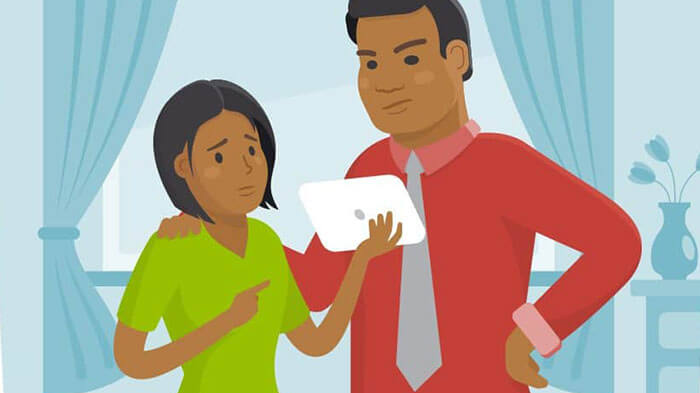
Provide Security, Teach, Follow
Always teach your children about the positive effects of the internet and technology. Talk about the fundamentals of safe use of the internet and follow their actions in the digital world.
Another option: To keep your child away from online dangers, you can install specific software or a family filter on your computer and encourage him/her to spend time with age-appropriate software and games. Check out our article, Cybersecurity for Kids, for detailed information.
IMPORTANT: Choose apps that offer age-appropriate and practical benefits to help your child enjoy screen time.
MentalUP, described as a pedagogical product by the Mental Health Association, ensures that your child stays away from uncontrolled content and also develops thinking and learning skills.
Follow Your Child in the Outside World
Don't just follow your child's online usage habits, be in constant contact with schools and teachers. Attend the parent meetings and ask teachers for their observations.
Don't forget to chat with your child's friends. Children can easily share the big problems (that they can’t share with their parents and adults) with their friends.
Observe What They Share
Keep track of your child's social media posts. These posts can give you ideas about your child's problems and their inner world.
Think if there is another meaning behind their messages and posts. Always keep in touch with his/her personal profile, even if your child doesn't want it. Get involved with their list of friends and become a loyal follower.
Do not abuse this privilege. Don't comment and share about your child. In the same way, do not interpret his/her shares. Be a ghost follower and use the advantage of being invisible.
Block Cyberbullies
Is your child in trouble with a cyberbully? Immediately stop the bully and keep your child out of contact with this person. If the bully is someone familiar, share the problem with his/her family and school management, or the guidance service.
A problem that seems insignificant from the outside can be very important for victims of cyberbullying. If you feel that some events you experienced affected your child, you should definitely contact professional support.
Limit Technology and Internet Access
We are sure that they don’t want this at all, but children up to a certain age should be prevented from the unlimited use of technology and the internet. But be careful! Do not completely prohibit technology for your child: Only apply limitations.
Technology and the internet are no longer what they were at our young ages. All of your children’s friends enjoy the blessings of technology while having fun, so do not cause them to be deprived of this pleasure. Just keep it under control - limit activity and usage times.
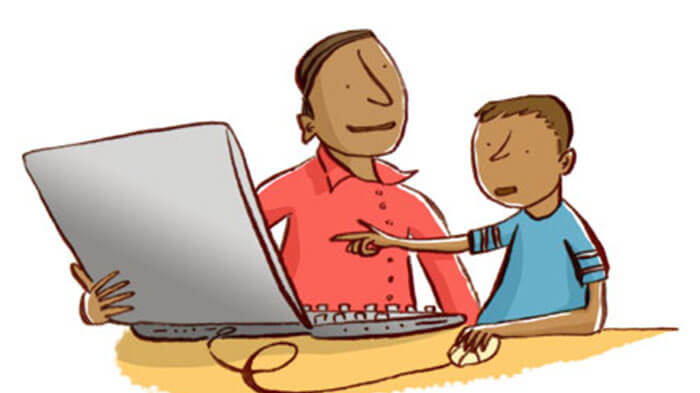
How to Report Cyberbullying
Reporting cyberbullies is important to ensure the safety of children. Here are the steps that you can take to make sure that the perpetrator faces the consequences of cyberbullying.
Immediate Action
Here are the first steps to take that are recommended by the U.S. authorities.
- Don’t respond to and don’t forward cyberbullying messages.
- Keep evidence of cyberbullying. Keep track of the dates, times, and descriptions of instances when the incident has occurred. Save and print screenshots, emails, and text messages. Use this evidence to report those actions to web and cell phone service providers.
- Block the person who is cyberbullying.
Report Cyberbullying to Online Service Providers
Most social media platforms and internet service providers do not tolerate cyberbullying! Follow these steps to inform them of the violation of the terms of services.
- To learn which kind of content is appropriate or not, visit their terms and conditions or rights and responsibilities sections.
- Change your settings, block users, and control who can and can’t contact you. If you don’t know how, all you have to do is visit social media safety centers.
- Report the abuse of terms of services to the social media platform so they can take action against the cyberbully.
Report Cyberbullying to Law Enforcement
Cyberbullying is considered a crime when it involves these activities:
- Threats of violence
- Child pornography or sending sexually explicit messages or photos
- Taking a photo or video of someone in a place where he or she would expect privacy
- Stalking and hate crimes
The laws and legislations on cyberbullying may vary depending on countries and states. If you’re not sure and asking yourself: “Is cyberbullying illegal?” consult a legal expert for additional guidance.
Report Cyberbullying to Schools
Cyberbullying at school can cause an unhealthy environment and it often can be linked to in-person bullying.
- The school can use the information reported on cyberbullying to help inform, prevent, and create response strategies.
- Some schools keep students accountable for their cyberbullying activities off-campus. Getting in touch with your child’s school and learning their procedures for these sorts of behavior may help.
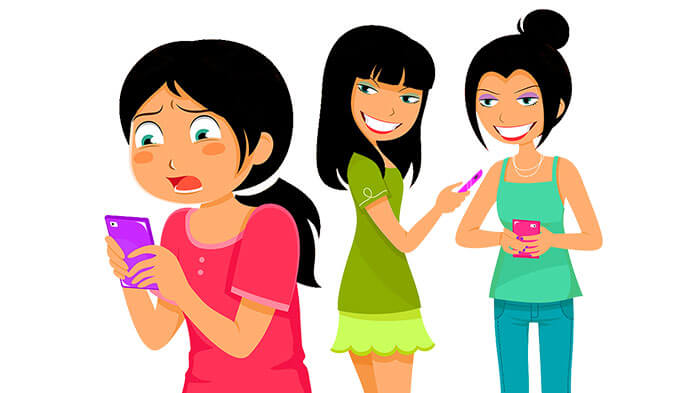
What You Should Do If Your Child Is a Cyberbully?
Let's not forget to look at the other side of the coin: Your child can also be a cyberbully! It is a pity for every parent to learn that his or her child displays bad behavior. However, if there is such a problem, you should take action and find the right solutions to cyberbullying instead of avoiding the problem and waiting for a spontaneous recovery. Here is a list of steps to consider when helping your child change their behavior:
Put Your Feelings Away
Parents who find out that their child is a cyberbully tend to feel strong emotions like anger, embarrassment and guilt. To focus on their actions, motivation, and needs, keep your thoughts and emotions to yourself as they speak.
Carefully Consider the Best Way to Handle the Situation
Finding ways on how to deal with cyberbullying is hard no matter which side of the coin you're on. While deciding on your approach, you have to consider your child’s age, the length of time the cyberbullying has been going on, the severity of the situation, and so on.
Who Needs to Be Involved in the Process and Who Doesn’t?
Is it enough that you handle this situation on your own, or do you need extra help? Evaluate your situation and decide whether or not you have to extend the scope.
Sit Down and Talk
The conversation that will take place should be in a calm environment with all focus on the child/teen and their actions. Keep in mind that you may be the last person to be informed about the cyberbullying (the school and possibly law enforcement may be first responders). If so, step in and coordinate from the point of your involvement.
Learn Why They Did It
Why do people cyberbully? There aren’t any excuses for it, however, it is important to understand why your child or teen chose to act in this manner. Try to figure out if there are underlying issues that also need to be addressed.
Face Them With the Consequences of Cyberbullying
There may also be measure imposed by their school, their team, or even by the court. Possible measures you can implement:
Restricted Internet Privileges
Limit their time online. If they need to use the internet for homework, supervise their usage.
Restrictions in Free Time
Grounding children can seem harsh, but giving them the opportunity to think about their actions can be very beneficial. Plus, if they were affected by other cyberbullies, it may be best for them to stay apart for a while.
Required Learning
Building compassion and empathy for the victim is based on gaining a deeper understanding of how damaging cyberbullying can be. Based on your child’s age, teach them the harmful effects of cyberbullying and how they may have hurt someone.
Reparations and Restitution
Even if they stop cyberbullying, the process is not over until there has been a change of heart and honest attempts at reparations have been made. Watch closely for any signs of retaliation. Children and teenagers hate getting in trouble and facing consequences so they find it easier to blame the victim instead.





